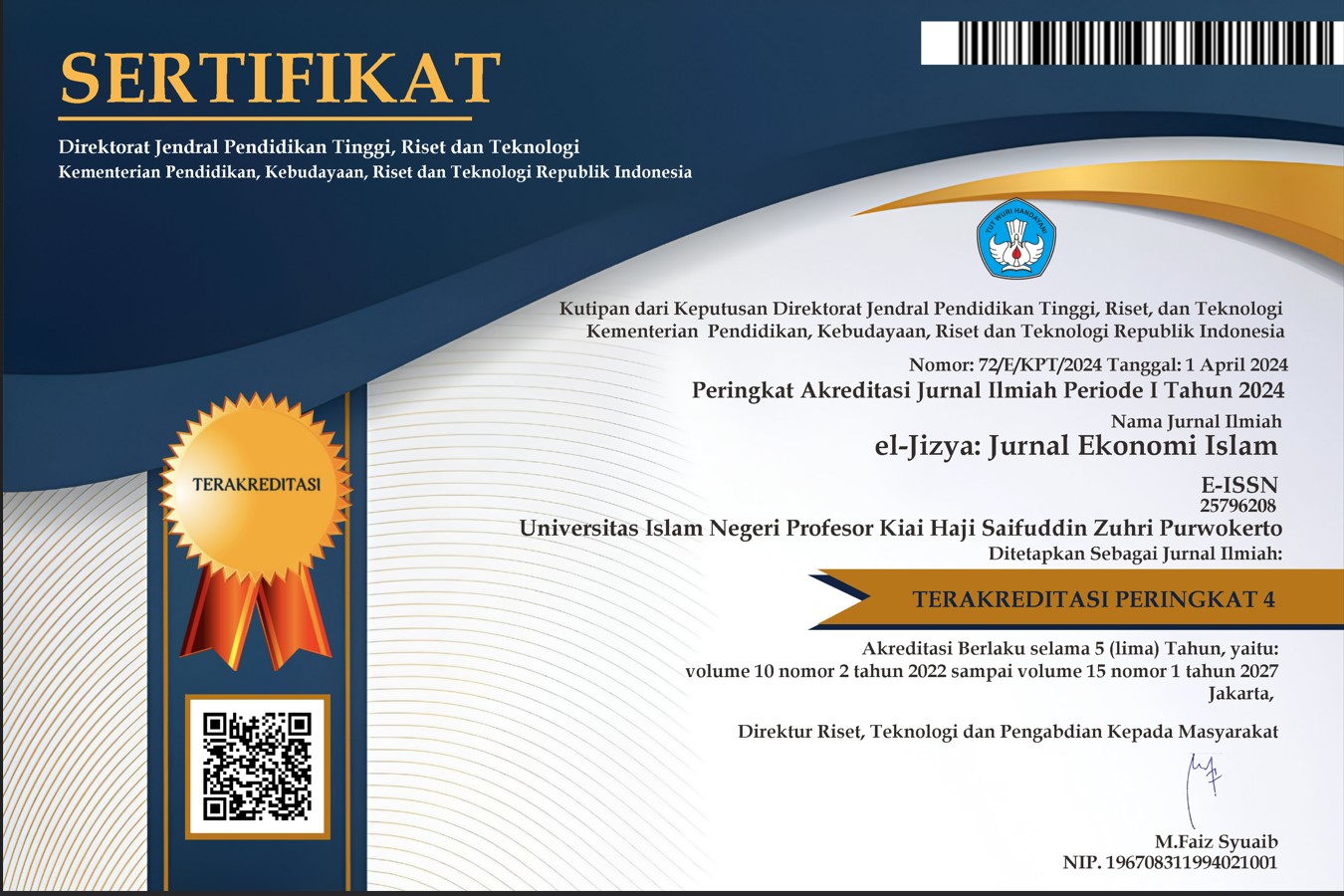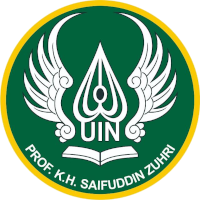Peran Instrumen Keuangan Negara Cash Waqf Linked Sukuk Dalam Meningkatkan Pembiayaan Ekspor UMKM Indonesia
DOI:
https://doi.org/10.24090/ej.v12i2.11579Keywords:
Cash Waqf Linked Sukuk, Export Financing, Cash WaqfAbstract
The aim of this research is to examine the role of the Cash Waqf Linked Sukuk instrument in increasing export financing for Indonesian MSMEs. This research employs a descriptive qualitative approach using secondary data obtained from literature studies. Cash waqf can be utilized not only in religious-based domains but also in productive economic sectors. In the context of developing Indonesian export trade, Islamic financial instruments, namely CWLS, serve as a source of funding for the government and are channeled to the Indonesian Export Financing (LPEI) Institution for financing MSMEs based on Sharia principles. Export financing will be repaid to LPEI which will be distributed to the government in the form of taxes, non-tax deductions and a share of government profits. On the other hand, the government provides periodic returns to BWI which are then distributed to Nadzir to be managed for social interests.References
Agarwal, N., & Wang, Z. (2018). Does the US EXIM Bank really promote US exports? World Economy, 41(5), 1378–1414. https://doi.org/10.1111/twec.12537
Alhusain, A. S. (2018). Perang Dagang AS dan China: Tantangan dan Peluang Ekspor Indonesia. Kajian Singkat Terhadap Isu Aktual Dan Strategis Buletin Bidang Ekonomi Dan Kebijakan Publik, X(14), 19–24.
Aziz, M. W. (2017). Wakaf Tunai Dalam Perspektif Hukum Islam. International Journal Ihya’ ’Ulum Al-Din, 19(1), 1. https://doi.org/10.21580/ihya.18.1.1740
Badan Pusat Statistik. (2020). Statistik Perdagangan Luar Negeri Indonesia.
Beck, V. (2018). Introduction to the special issue on normative aspects of international trade institutions. Moral Philosophy and Politics, 5(2), 173–180. https://doi.org/10.1515/mopp-2018-0072
Bulut, M., & Korkut, C. E. M. (2019). Ottoman cash waqfs: An alternative financial system. Insight Turkey, 21(3), 91–111. https://doi.org/10.25253/99.2018EV.07
Carriço, P. (2013). Export financing in Brazil: Challenges and opportunities. Global Policy, 4(1), 116–117. https://doi.org/10.1111/1758-5899.12021
Djppr. (2020). Cash Waqf Linked Sukuk Seri SWR001 “Kebaikan Jariyah Penuh Berkah.”
Duasa, J., & Thaker, M. A. B. M. T. (2016). a Cash Waqf Investment Model: an Alternative Model for Financing Micro-Enterprises in Malaysia. Journal of Islamic Monetary Economics and Finance, 1(2), 161–188. https://doi.org/10.21098/jimf.v1i2.533
Fad, M. F. (2021). WAQF LINKED SUKUK DALAM PERSPEKTIF MAQASHID SYARI’AH. Journal of Islamic Studies and Humanities, 6(1), 44–62.
Griffith, D. A., & Czinkota, M. R. (2012). Release the constraints: Solving the problems of export financing in troublesome times. Business Horizons, 55(3), 251–260. https://doi.org/10.1016/j.bushor.2012.01.003
Hartanto, R. S. W., & Dani, H. (2016). STUDI LITERATUR : PENGEMBANGAN MEDIA PEMBELAJARAN DENGAN SOFTWARE AUTOCAD Rizal Septa Wahyu Hartanto Hasan Dani Abstrak. 1–6.
Hasoloan, J. (2013). Peranan Perdagangan Internasional dalam Produktifitas dan Perekonomian. Jurnal Ilmiah Pend. Ekonomi, 1(2), 102–112. https://media.neliti.com/media/publications/271659-peranan-perdagangan-internasional-dalam-71f683a0.pdf
Hazami, B. (2016). MEWUJUDKAN KESEJAHTERAAN UMAT Salah satu dari bentuk ibadah untuk mendekatkan diri wakaf . Amalan wakaf sangat besar artinya bagi kehidupan ibadah yang amat digembirakan . 1 Wakaf merupakan salah Islam yaitu mewujudkan kehidupan yang sejahtera . Negara- s. Analisis, XVI, 173–204.
Huda, N., Idris, H. R., Nasution, M. E., & Wiliasih, R. (2008). Ekonomi Makro Islam Pendekatan Teoritis. Prenadamedia Group.
Indonesia Eximbank. (2020). Annual Report: Menjadi Penggerak Pembangunan di Masa Pandemi & Beraspirasi Menuju Resiliensi dengan Agility.
Jamilus. (2017). ANALISIS FUNGSI DAN MANFAAT WTO BAGI NEGARA BERKEMBANG ( KHUSUSNYA INDONESIA ) ( Analysis Of The Function And Benefits Of WTO For Developing Countries ( Especially Indonesia )) Abstrak. Jikh, 11(2), 205–225. https://ejournal.balitbangham.go.id/index.php/kebijakan/article/view/271
Kemenkeu. (2021). Anggaran Pendapatan dan Belanja Negara 2021. Kementerian Keuangan Direktorat Jenderal Anggaran, 1–48. https://www.pajak.go.id/id/artikel/mengenal-insentif-pajak-di-tengah-wabah-covid-19#:~:text=Pemberian fasilitas ini diberikan melalui,22 Impor kepada wajib pajak.&text=Ketiga adalah PPh Pasal 25,selama 6 bulan ke depan.
Kumar, S., & Milnar, L. (2006). Challenges and benefits of international trade on developed and transitional economies and individual companies: A case study. International Journal of Management and Enterprise Development, 3(6), 558–578. https://doi.org/10.1504/IJMED.2006.010354
Mahrus, M. L., & Yulianto, I. (2017). Analisis Atas Pembiayaan Ekspor Nasional Syariah Pada Lembaga Pembiayaan Ekspor Indonesia. Substansi, Volume 1(Nomor 2), 220–237. http://jurnal.pknstan.ac.id/index.php/SUBS/article/view/251
Mohsin, M. I. A. (2013). Financing through cash-waqf: a revitalization to finance different needs. International Journal of Islamic and Middle Eastern Finance and Management, 6(4), 304–321. https://doi.org/10.1108/IMEFM-08-2013-0094
MUI, D. (2002). Letter of Credit (L/C) Ekspor Syari’Ah.
Mukhlisin, M., & Mustafida, R. (2019). Revitalization of Waqf for Socio-Economic Development, Volume I. In Revitalization of Waqf for Socio-Economic Development, Volume I: Vol. I. Springer International Publishing. https://doi.org/10.1007/978-3-030-18445-2
Musari, K. (2019). The Evolution of Waqf and Sukuk toward Sukuk-Waqf in Modern Islamic Economy. International Journal of ‘Umranic Studies , 2(1), 45–54.
Rahayu, R. D., & Agustianto, M. A. (2020). Analisis Implementasi Cash Waqf Linked Sukuk (CWLS) Perspektif Prinsip Ekonomi Syariah. Management of Zakat and Waqf Journal (MAZAWA), 1(2), 145–161. https://doi.org/10.15642/mzw.2020.1.2.145-161
Rahman, M. I. F., Nurwahidin, N., & Adnan, N. (2021). Analisis Model Cash Waqf Linked Sukuk (CWLS) Sebagai Instrumen Pembiayaan Pemulihan Dampak Pandemi Covid-19. Jurnal Bimas Islam, 14(1), 77–102. https://doi.org/10.37302/jbi.v14i1.343
Samsu. (2017). Metode penelitian: teori dan aplikasi penelitian kualitatif, kuantitatif, mixed methods, serta research & development. In Diterbitkan oleh: Pusat Studi Agama dan Kemasyarakatan (PUSAKA).
Shah, M. W. M. and S. S. (2019). The Use of Zakat Revenue in Islamic Financing: Jurisprudential Debate and Practical Feasibility. Journal: Studies in Islam and the Middle East, 6(1), 1–15.
Tanjung, H. (2018). an Integration of Waqf and Ventura Capital: a Proposed Model for Indonesia. Journal of Islamic Monetary Economics and Finance, 3, 163–182. https://doi.org/10.21098/jimf.v3i0.910
Tanjung, H., & Windiarto, A. (2021). Role of Cash Waqf Linked Sukuk In Economic Development and International Trade. Signifikan: Jurnal Ilmu Ekonomi, 10(2), 275–290. https://doi.org/10.15408/sjie.v10i2.20493
Usman, M., & Ab Rahman, A. (2021). Funding higher education through waqf: a lesson from Pakistan. International Journal of Islamic and Middle Eastern Finance and Management, 14(2), 409–424. https://doi.org/10.1108/IMEFM-05-2019-0200
Yasin, R. M. (2021). Cash Waqf Linked Sukuk: Issues, Challenges and Future Direction in Indonesia. Jurnal Ekonomi Dan Bisnis Islam (Journal of Islamic Economics and Business), 7(1), 100. https://doi.org/10.20473/jebis.v7i1.24818
Downloads
Published
How to Cite
Issue
Section
License
Copyright (c) 2024 Annisa Rahma Febriyanti, Dian Ghani Reza Dasangga

This work is licensed under a Creative Commons Attribution-ShareAlike 4.0 International License.
Authors who publish with this journal agree to the following terms:
- Authors retain copyright and grant the journal right of first publication with the work simultaneously licensed under a Creative Commons Attribution-ShareAlike License that allows others to share the work with an acknowledgement of the work's authorship and initial publication in this journal.
- Authors are able to enter into separate, additional contractual arrangements for the non-exclusive distribution of the journal's published version of the work (e.g., post it to an institutional repository or publish it in a book), with an acknowledgement of its initial publication in this journal.
- Authors are permitted and encouraged to post their work online (e.g., in institutional repositories or on their website) prior to and during the submission process, as it can lead to productive exchanges, as well as earlier and greater citation of published work (See The Effect of Open Access).















